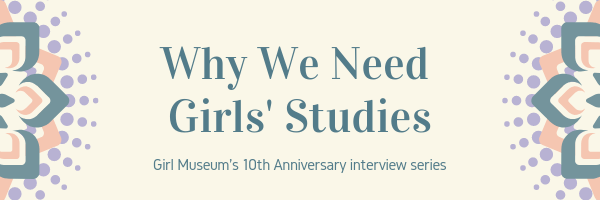Welcome to Girl Museum’s 10th Anniversary year. We have many exciting projects for our community, including this new blog series, Why We Need Girls’ Studies. Each month we will feature an interview with a scholar in the field to get insights about what we are all doing in this space to further our understanding of girlhood and its experiences.
Our fourth interview is with Dr. Sarah Godfrey, Senior Lecturer in the School of Film, Television and Media Studies at the University of East Anglia.
Let’s begin with defining our terms, especially since Girls’ Studies is a relatively new academic area. Can you tell our readers what your field of expertise is and how you see it within Girls’ Studies?
My academic area of study is broadly feminist media and cultural studies. My main interest is the representation of gender, sexuality, class and race in both British and American film and television. Within this, I have begun to develop a specific interest in the ways in which girls and girls cultures are represented as well as beginning to think more about the ways in which girls respond to the images and ideas about gender that are in the media that they consume.
Why do you think we need Girl Studies?
Broadly speaking, the world needs Girls Studies because girls are, by virtue of their gender and age, always at least doubly disempowered. From the perspective of my own discipline and more broadly within culture, girl culture remains undervalued and marginalised. It remains the case within popular cultural discourse that girls cultural forms are not important and not worthy of attention. From the media texts that girls consume through to cultural and social practices of girlhood, girls’ culture, girls’ interests and girls’ lived social practices are seen as trivial. The relative lack of academic work around girls and media is indicative of this lowly position. As a Girls Studies scholar, I argue that girls culture is absolutely fascinating, creative and vibrant and that in ignoring girls and their cultural practices, academia perpetuates patriarchal hierarchies which consistently derogate and dismiss girls.
There are vast disparities globally in girls’ situations, with incremental improvements in some areas and serious steps backwards in others. From your work in Girls’ Studies, what are some positives you take away from the academic interest in girls and girlhood? What changes can it lead to?
For me, the biggest potential is in the opportunities of collaboration between scholars, girls and also policy makers. I work alongside colleagues from a number of British universities with the NGO Plan UK who are one of the most important policy and advocacy organisations working for and alongside girls. From work on period poverty and girls’ rights in the UK to creating the first substantive data sets on girls lives in the UK, the partnership has the potential to bring to bear political pressure and (hopefully) change.
The second positive for me is more personal. I find working alongside and in collaboration with girls to be incredibly invigorating. I am always humbled by their enthusiasm, articulacy, and hunger to change things. The passion of the girls that I have worked with is unquestionable. Not only do I learn from them, I also have every faith that the generation of girls who are coming up through school at the moment will create huge changes that benefit us all.
What are the biggest challenges now and going forward for Girls Studies in an academic world? Do you see Girls’ Studies programs being a reality?
Well, I was once challenged by a senior male colleague who demanded to know ‘girl studies? Is that actually a thing?’ – so, hand in hand with the ways in which girls’ culture is devalued, so too is girls studies. I think that being a relatively new discipline is always difficult but I think the main challenge is for our work to be understood as serious, valuable and important.
While I would love to say yes to the question of girls’ studies programs, my sense is, certainly in the UK, that this is incredibly unlikely to happen anytime soon. There have been major changes in terms of funding and the market place of higher education; universities are becoming increasingly risk averse and so I think that what is more likely is that girls studies will remain disparate and located across and between many disciplines. That said, this is not necessarily a weakness, indeed, as scholars we need to capitalise on the interdisciplinary opportunities within the field and use these to push the field further.
We have an ongoing research question we ask everyone we interview: Do you think the Internet is a safe place for girls and why?
Goodness, that is a difficult question but sadly, the answer is no. It could be and it absolutely should be, but at the moment it is not and for all sorts of reasons. Even as an adult with a public facing job, identifying as a feminist or expressing political thoughts can lead to a twitter feed full of rape threats and the like. I think the other thing that comes to mind with this question, is the importance of listening to girls themselves. In the course of workshops that I have run over the last year or so, the question of safe places has come up and over 90% of the girls across these various workshops did not feel that the internet was a space of safety.
For more information about Dr. Godfrey and her work, read her bio. Join us next month for another interview of a Girlhood Studies scholar, Dr. Relebohile Moletsane of the University of University of KwaZulu-Natal.
Thanks for reading!
-Ashley E. Remer
Head Girl
Girl Museum Inc.

